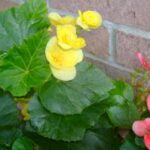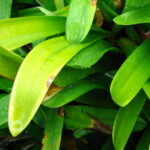Of the three major categories of begonias, the rhizomatous and fibrous-rooted are grown most often as house plants, while tuberous begonias make ideal candidates or hanging baskets on porches and patios. The best-known member of the large begonia family is the fibrous-rooted ever blooming group called wax begonia, with its shiny or waxy leaves. Flowers range from red and pink shades to white, arid may be single or double. Grow wax begonias indoors or out. Must fibrous-rooted kinds grow about a foot tail; the popular angel-wing begonia stretches higher.
Begonias grown primarily for their beautiful foliage belong to the rhizomatous rex group. Hairy, textured leaves arise from their short rhizomes. Foliage color may be purple and green, silver and green, or the distinctive rich chocolate and green of the iron cross begonia. Provide filtered light for the glamorous rex begonias all year long.
Tuberous begonias rank among the showiest of flowering plants. Flowers range in size from three to eight inches in diameter, and come in double and single form with plain, ruffled, and frilled petals. Colors available include apricot, orange, salmon, yellow, crimson, scarlet, pink, rose, and white. Hang this trailing begonia outside for summer-long pleasure. It delights in fresh, clean air.
Light
Most begonias don’t like too much sun. They do well in open shade or with some early east sun. They withstand some winter sun better than hot summer sun, which should be filtered. For the most blooms, grow wax begonias in a sunny window during the winter when the sun is less intense.
Water
Keep the soil evenly moist; avoid extremes of too wet or too dry. Water as soon as soil surface feels dry. Good drainage is essential; waterlogged soil will rot roots.
Special helps
Pot up begonias in a loose soil mixture containing plenty of organic matter. Use two parts compost or other available organic matter, one part perlite or coarse sand, and one part good garden loam.
Use care in fertilizing- a slow-release type of houseplant food works best. Give a light feeding every couple of weeks when begonias are blooming.
Diseases and insects to be on guard against include bacterial leaf spot, botrytis blight, stem rot, and mealybugs. Bacterial leaf spot causes blister like spots on the foliage. Pick infested leaves and burn them. Botrytis blight and stem rot turn plant parts brown and black. Remove infected areas and burn. If mealybugs appear, touch each pest with a cotton swab saturated with rubbing alcohol.
Propagate fibrous rooted begonias such as wax begonias by stem cuttings. Remove the lower leaves from three- to four- inch-long cuttings and stick the stem ends in a moist rooting medium such as vermiculite or sand. Then, cover with a clear plastic bag to create a moist, greenhouse-like atmosphere. To keep the plastic from touching the foliage, which can cause rotting, insert stakes into the medium. Keep the cuttings in a warm spot out of direct sun. Allow three weeks for the cuttings to root, and then pot them up.
Propagate rhizomatous begonias having leaves with large veins, such as the rex types, by leaf cuttings. Remove a leaf along with one inch of leaf stem from a mature plant. Insert the stem in a moist rooting medium. Anchor the leaf, face up, with toothpicks and sever each main vein. Cover the pot with plastic to maintain high humidity. Roots and plantlets will form at the out points. When plantlets develop several small leaves, remove them from the parent leaf and pot up individually.
Or, cut the big leaf apart so each section includes a part of the main stem. Remove and discard the tips of each piece to reduce wilting problems during the rooting process, and insert the base of leaf sections in sand, vermiculite, or perlite. To keep the leaf piece from toppling, sink the lower third into the rooting medium. Open the medium with a knife. If you try to push the soft leaf into the medium, you’ll crush and ruin it. Check for good roots after two or three weeks. Then pot up each in a two- or three-inch pot.
Start summer-flowering tuberous begonias from tubers in February or March. Set the tubers in a shallow container of loose, moist rooting medium such as vermiculite, leaving the pinkish buds exposed. When rooted, pot up in five-inch or larger pots, depending on size of the new root system.
Water sparingly at first, increase amount of water as the plants grow and can use more moisture. In fall when plants show signs of resting, gradually withhold water. When tops have died down, store tubers in dry vermiculite or sand.




